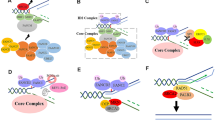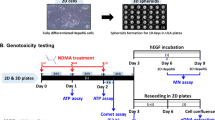Abstract
Formaldehyde (FA), a major industrial chemical and ubiquitous environmental pollutant, has recently been classified by the International Agency for Research on Cancer as a human leukemogen. The major mode of action of FA is thought to be the formation of DNA–protein cross-links (DPCs). Repair of DPCs may be mediated by the Fanconi anemia pathway; however, data supporting the involvement of this pathway are limited, particularly in human hematopoietic cells. Therefore, we assessed the role of FANCD2, a critical component of the Fanconi anemia pathway, in FA-induced toxicity in human lymphoblast cell models of FANCD2 deficiency (PD20 cells) and FANCD2 sufficiency (PD20-D2 cells). After treatment of the cells with 0–150 μM FA for 24 h, DPCs were increased in a dose-dependent manner in both cell lines, with greater increases in FANCD2-deficient PD20 cells. FA also induced cytotoxicity, micronuclei, chromosome aberrations, and apoptosis in a dose-dependent manner in both cell lines, with greater increases in cytotoxicity and apoptosis in PD20 cells. Increased levels of γ-ATR and γ-H2AX in both cell lines suggested the recognition of FA-induced DNA damage; however, the induction of BRCA2 was compromised in FANCD2-deficient PD20 cells, potentially reducing the capacity to repair DPCs. Together, these findings suggest that FANCD2 protein and the Fanconi anemia pathway are essential to protect human lymphoblastoid cells against FA toxicity. Future studies are needed to delineate the role of this pathway in mitigating FA-induced toxicity, particularly in hematopoietic stem cells, the target cells in leukemia.





Similar content being viewed by others
References
Baan R, Grosse Y, Straif K, Secretan B, El Ghissassi F, Bouvard V, Benbrahim-Tallaa L, Guha N, Freeman C, Galichet L, Cogliano V (2009) A review of human carcinogens–Part F: chemical agents and related occupations. Lancet Oncol 10:1143–1144
Bauchinger M, Schmid E (1985) Cytogenetic effects in lymphocytes of formaldehyde workers of a paper factory. Mutat Res 158:195–199
Bonassi S, El-Zein R, Bolognesi C, Fenech M (2011) Micronuclei frequency in peripheral blood lymphocytes and cancer risk: evidence from human studies. Mutagenesis 26:93–100
Costa M, Zhitkovich A, Gargas M, Paustenbach D, Finley B, Kuykendall J, Billings R, Carlson TJ, Wetterhahn K, Xu J, Patierno S, Bogdanffy M (1996) Interlaboratory validation of a new assay for DNA-protein crosslinks. Mutat Res 369:13–21
D’Andrea AD, Grompe M (2003) The Fanconi anaemia/BRCA pathway. Nat Rev Cancer 3:23–34
de Graaf B, Clore A, McCullough AK (2009) Cellular pathways for DNA repair and damage tolerance of formaldehyde-induced DNA-protein crosslinks. DNA Repair (Amst) 8:1207–1214
Fenech M (2000) The in vitro micronucleus technique. Mutat Res 455:81–95
Friedenson B (2011) A common environmental carcinogen unduly affects carriers of cancer mutations: carriers of genetic mutations in a specific protective response are more susceptible to an environmental carcinogen. Med Hypotheses 77:791–797
Grafstrom RC, Fornace A Jr, Harris CC (1984) Repair of DNA damage caused by formaldehyde in human cells. Cancer Res 44:4323–4327
Heck HD, Casanova-Schmitz M, Dodd PB, Schachter EN, Witek TJ, Tosun T (1985) Formaldehyde (CH2O) concentrations in the blood of humans and Fischer-344 rats exposed to CH2O under controlled conditions. Am Ind Hyg Assoc J 46:1–3
Houghtaling S, Timmers C, Noll M, Finegold MJ, Jones SN, Meyn MS, Grompe M (2003) Epithelial cancer in Fanconi anemia complementation group D2 (Fancd2) knockout mice. Genes Dev 17:2021–2035
IARC (1995) Formaldehyde. IARC Monogr Eval Carcinog Risks Hum 62:217–375
IARC (2006) Formaldehyde, 2-butoxyethanol and 1-tert-butoxypropan-2-ol. IARC Monogr Eval Carcinog Risks Hum 88:1–478
Jakab MG, Klupp T, Besenyei K, Biro A, Major J, Tompa A (2010) Formaldehyde-induced chromosomal aberrations and apoptosis in peripheral blood lymphocytes of personnel working in pathology departments. Mutat Res 698:11–17
Lorenti Garcia C, Mechilli M, Proietti De Santis L, Schinoppi A, Kobos K, Palitti F (2009) Relationship between DNA lesions, DNA repair and chromosomal damage induced by acetaldehyde. Mutat Res 662:3–9
Merk O, Speit G (1998) Significance of formaldehyde-induced DNA-protein crosslinks for mutagenesis. Environ Mol Mutagen 32:260–268
Nakano T, Katafuchi A, Matsubara M, Terato H, Tsuboi T, Masuda T, Tatsumoto T, Pack SP, Makino K, Croteau DL, Van Houten B, Iijima K, Tauchi H, Ide H (2009) Homologous recombination but not nucleotide excision repair plays a pivotal role in tolerance of DNA-protein cross-links in mammalian cells. J Biol Chem 284:27065–27076
Noda T, Takahashi A, Kondo N, Mori E, Okamoto N, Nakagawa Y, Ohnishi K, Zdzienicka MZ, Thompson LH, Helleday T, Asada H, Ohnishi T (2011) Repair pathways independent of the Fanconi anemia nuclear core complex play a predominant role in mitigating formaldehyde-induced DNA damage. Biochem Biophys Res Commun 404:206–210
NTP (2010) Final report on carcinogens background document for formaldehyde. Rep Carcinog Backgr Doc 10-5981:i-512. http://www.ncbi.nlm.nih.gov/pubmed/20737003
Parmar K, Kim J, Sykes SM, Shimamura A, Stuckert P, Zhu K, Hamilton A, Deloach MK, Kutok JL, Akashi K, Gilliland DG, D’Andrea A (2010) Hematopoietic stem cell defects in mice with deficiency of Fancd2 or Usp1. Stem Cells 28:1186–1195
Reliene R, Yamamoto ML, Rao PN, Schiestl RH (2010) Genomic instability in mice is greater in Fanconi anemia caused by deficiency of Fancd2 than Fancg. Cancer Res 70:9703–9710
Ridpath JR, Nakamura A, Tano K, Luke AM, Sonoda E, Arakawa H, Buerstedde JM, Gillespie DA, Sale JE, Yamazoe M, Bishop DK, Takata M, Takeda S, Watanabe M, Swenberg JA, Nakamura J (2007) Cells deficient in the FANC/BRCA pathway are hypersensitive to plasma levels of formaldehyde. Cancer Res 67:11117–11122
Rosado IV, Langevin F, Crossan GP, Takata M, Patel KJ (2011) Formaldehyde catabolism is essential in cells deficient for the Fanconi anemia DNA-repair pathway. Nat Struct Mol Biol 18:1432–1434
Speit G, Schutz P, Merk O (2000) Induction and repair of formaldehyde-induced DNA-protein crosslinks in repair-deficient human cell lines. Mutagenesis 15:85–90
Thompson LH, Hinz JM (2009) Cellular and molecular consequences of defective Fanconi anemia proteins in replication-coupled DNA repair: mechanistic insights. Mutat Res 668:54–72
Thomson EJ, Shackleton S, Harrington JM (1984) Chromosome aberrations and sister-chromatid exchange frequencies in pathology staff occupationally exposed to formaldehyde. Mutat Res 141:89–93
Timmers C, Taniguchi T, Hejna J, Reifsteck C, Lucas L, Bruun D, Thayer M, Cox B, Olson S, D’Andrea AD, Moses R, Grompe M (2001) Positional cloning of a novel Fanconi anemia gene, FANCD2. Mol Cell 7:241–248
Zhang L, Freeman LE, Nakamura J, Hecht SS, Vandenberg JJ, Smith MT, Sonawane BR (2010a) Formaldehyde and leukemia: epidemiology, potential mechanisms, and implications for risk assessment. Environ Mol Mutagen 51:181–191
Zhang L, Tang X, Rothman N, Vermeulen R, Ji Z, Shen M, Qiu C, Guo W, Liu S, Reiss B, Freeman LB, Ge Y, Hubbard AE, Hua M, Blair A, Galvan N, Ruan X, Alter BP, Xin KX, Li S, Moore LE, Kim S, Xie Y, Hayes RB, Azuma M, Hauptmann M, Xiong J, Stewart P, Li L, Rappaport SM, Huang H, Fraumeni JF Jr, Smith MT, Lan Q (2010b) Occupational exposure to formaldehyde, hematotoxicity, and leukemia-specific chromosome changes in cultured myeloid progenitor cells. Cancer Epidemiol Biomarkers Prev 19:80–88
Zhitkovich A, Costa M (1992) A simple, sensitive assay to detect DNA-protein crosslinks in intact cells and in vivo. Carcinogenesis 13:1485–1489
Acknowledgments
We are grateful to Prof. Toshiyasu Taniguchi from the Fred Hutchinson Cancer Research Center, Seattle, WA, for generously providing us with the human lymphoblast PD20 and PD20-D2 cells. This work was supported by National Institute of Environmental Health Sciences, National Institute of Health grant R01ES017452 to Dr. L Zhang.
Author information
Authors and Affiliations
Corresponding author
Additional information
Xuefeng Ren and Zhiying Ji contributed to this work equally.
Rights and permissions
About this article
Cite this article
Ren, X., Ji, Z., McHale, C.M. et al. The impact of FANCD2 deficiency on formaldehyde-induced toxicity in human lymphoblastoid cell lines. Arch Toxicol 87, 189–196 (2013). https://doi.org/10.1007/s00204-012-0911-6
Received:
Accepted:
Published:
Issue Date:
DOI: https://doi.org/10.1007/s00204-012-0911-6




